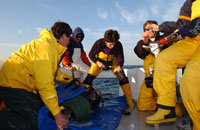

The Tag team sat out one day as a cold front came in- and we were back out at the shad boat buoy area Thursday aboard the F/V Sensation and tagged and released a bluefin tuna that measured 82 inches. This fish was tagged by Dr. Andre Boustany with a pop- up satellite and archival tag. Thats close to $5000 of electronic equipment on one fish. We were fortunate to get a fish as only 7-8 were landed with a fleet of over 40 commercial boats. The electronic tags will provide information on where the bluefin tuna go after wintering in the Carolinas by recording sunrise and sunset information along with accurately keeping time. Its quite an engineering effort to do this- 17th century Astronomy algorithms running on 21st century tags- all inside the body of a bluefin tuna- if he or she only knew. The pop-up satellite tags (PAT) we're putting out are scheduled for pop-off at 210 days to 270 days- the archival tags are capable of measuring where a bluefin goes for over 5 years- this latter implantable tag requires retrieval- and we mark the fish with two very bright green conventional tags that points out to a fisher with Green- that there is a $1000 reward for recapture. Because there has yet to be an NC recapture- the first ever bluefin recpatured in NC has years of prizes riding on it- including a trip to Monterey! The PAT satellite tag should allow enough time to examine where the bluefin goes to breed. One major question in bluefin tuna biology is how old is a fish that goes to spawn? To date, we've found we have to tag bluefin tuna in North Carolina that are primarily above 94 inches to ensure the bluefin tuna tagged will end up in the Gulf of Mexico. We've seen one fish of 8 years of age from Carolina go there- but most of our fish from this winter fishery- or from the North- who end up in the Gulf of Mexico- are closer to 12 years of age. The fish we measure in North Carolina are 74 to 94 inches with just a few above 100 inches. Thus far this year - the bluefin that we're tagging are in the typical range of sizes (8-10) years of age- a few fish smaller (6 years of age) and a few fish slightly older (12 years of age) are also here. We have hypothesized that many of these fish are adolescents a year or two prior to going to the Gulf of Mexico, and some of these fish are Mediterranean breeders- others wander to the Bahamas or offshore Gulf Stream waters to the southwest where they may also potentially breed. Up in Canada earlier in the year we primarily tagged very large fish- that measured 108 inches to 125 inches. We think most will go during the spawning season to the Gulf of Mexico. Here in North Carolina we're taking genetic samples to confirm the assignment of the fish to populations (Gulf or Med). If this year is like the prior years- we'll find many of the Carolina bluefin are migrants from the Mediterranean who came over as juveniles - grew up on our shores, and will head back in a year or two. I am posting two tracks- one of a western origin track- a fish that was tagged in North Carolina and went to the Gulf (this fish was quite large)- and a fish that went to the Med from North Carolina. We don't know if these schools of Gulf and Med fish stay discrete while foraging or are completely mixed- but what we do know is this-bluefin from both origins are here- being landed. There are many questions remaining to be addressed. My favorite is just why are bluefin here at this location- Cape Lookout? More about this later- Barb




2 comments:
Excellent information Barb. I've followed your site since transfering 00-935. Keep up the good work. John
Barb how are you ? My name is Brodie Creed a tuna fisher from p.e.i.....My question to you is can you tell me who some Moly women is she did some tagging up here last summer ...the murray brothers were with a boat from up here..We are for science here if it is conducted in an open an transparent way.Anyway i heard Dr.John Nelison from d.f.o. here in canada give a report on the gulf population ....very intersting...if in the future you were interested in tagging in the gulf you should contact the P.E.I. fisherman through the proper channles....keep up the good work
Post a Comment